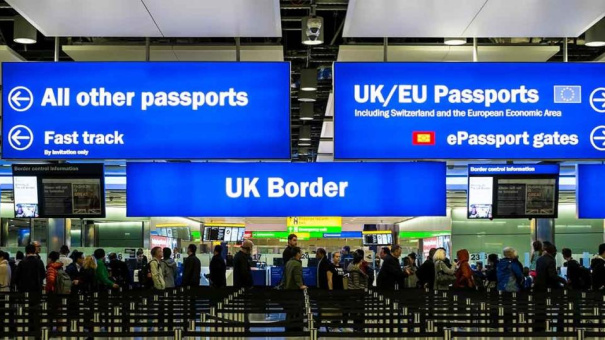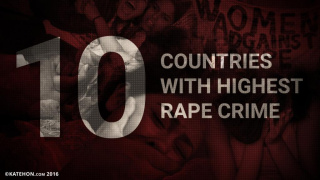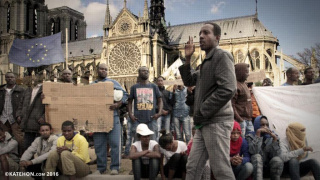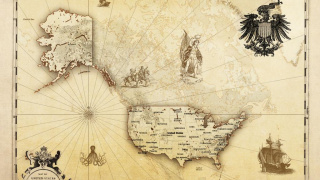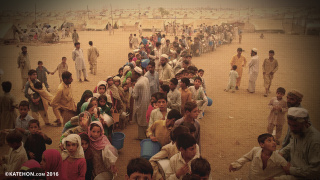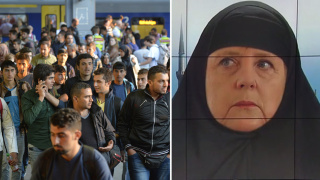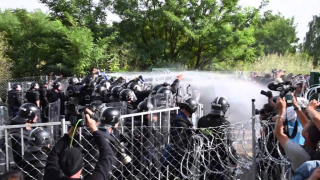IMMIGRATION – AN AUSTRO-LIBERTARIAN ANALYSIS
Both the referendum on Britain’s membership of the European Union and the election of Donald Trump as the US President have elevated the topic of immigration to the top of the political agenda. Leftist, liberal elites – previously so sure they would arrive easily at their vision of an open, borderless world – have been scalded now that the lid has been lifted from the bubbling cauldron of the needs of ordinary, everyday citizens seeking to preserve their jobs and the culture of their homelands.
It is high time that this vitriolic, divisive and – frankly – often quite tiresome issue is put to rest. That, alas, is unlikely to happen, particularly as the political globalists seem content to plough on with their vision of open borders through the looming UN Global Compact for Migration. Listening to the mainstream arguments (or at least to how the leftist/liberal media chooses to portray them), one would be forgiven for thinking that the immigration question needs to be met by an all or nothing answer – i.e. that it is either an unqualified good or an unqualified bad. We are led to believe that it is a contest between liberals, or self-styled “progressives”, clamouring for fully porous borders on the one hand, versus elderly, conservative, racist bigots who supposedly want to keep everyone out and preserve England’s green and pleasant land for white faces.
The falsehood of this dichotomy is obvious to almost anyone who is not of the liberal-left, and, in fact, a “sensible” view on immigration is quite prevalent – that it is possible to be in favour of permitted, but regulated immigration, allowing some people to cross the border as immigrants to come and live and work in the territory of the state while denying that privilege to others. It is also recognised that immigration is economically beneficial in some situations, but not in others – i.e. when immigrants are highly skilled and productive instead of welfare consumers.
The task of this essay is to sharpen this “sensible” view with Austro-libertarian theory. We will begin by outlining the core libertarian theory concerning immigration before examining a key area for contention among libertarians – whether, in a world populated by states, any particular state should restrict or otherwise control movements across the border by persons who are not considered to be citizens of that particular state and whether this is in accordance with libertarian theory. We will then move on to exploring the economic and cultural implications of immigration policies.
Immigration in Libertarian Theory
In strict libertarian theory there is no treatment of immigration separate from the general libertarian approach to private property. In a libertarian world all pieces of homesteaded land would be owned by private individuals. Although the owners of neighbouring pieces of land may share a common language, ethnicity and culture, there would be no legally defined national borders; all we would have are the borders, or rather, the boundaries of each parcel of private property marking the point where one person’s ownership ends and another person’s begins.
Who, how and when other individuals cross these borders is a private matter for the property owner. It is his property and he can welcome and exclude whomever he likes and on whichever terms he likes. If the property in question is his home then his closest, most immediate family, who may also live there, are likely to have unrestricted access; more distant family and friends may be granted access at mutually agreeable times when they wish to see each other; a lodger will have access governed by a tenancy or licence agreement; and “handymen” or contractors may be granted temporary access to carry out certain work that the owner pays them to undertake. Everybody else in the world, on the other hand, is likely to be excluded. At no point, prior to any agreement or contract with the owner, does any person have a legal right to cross the border of another person’s property. An uninvited crossing is, in libertarian theory, defined as unlawful, aggressive behaviour and may be met legitimately with physical resistance. The only places where people could wander wherever they please, except for their own property, would be onto un-homesteaded or ownerless land, as only in this condition would they be undertaking an action which does not interfere with the prior rights of another individual.
In a world populated by states, however, there are not just borders or boundaries between privately owned pieces of land; rather, there are borders between whole swathes of territory which form the landmass of the states. A particular stretch of land immediately on one of these borders need not be privately owned. It may be publicly owned – if it is, say, a road or a park – or even ownerless if it is an unkempt meadow (although the state will, of course, claim ownership over all un-homesteaded land).
In such a world the question concerning immigration would not be whether immigrants would have the right to enter your home or, say, your privately owned business premises. Not even the staunchest supporter of immigration contends that this should be the case (at least not yet, anyway). Moreover, if we assume, as minarchists do, that the state has a legitimate responsibility to protect individual parcels of privately owned property from uninvited access by either foreign or domestic individuals then this stance is perfectly in accordance with libertarian theory. Rather, the issue concerns whether the state should grant, without question, prospective immigrants a right to enter the territory of the state at certain, designated points on the border onto either publicly owned or ownerless land that the state claims is within its jurisdiction. This, necessarily, raises the further question of whether successful immigrants would be at liberty to access all publicly owned territory further inland (such as roads), to use publicly funded facilities and to claim publicly funded welfare.
In this imperfect world of state borders the question we as libertarians have to answer boils down to how, in libertarian theory, we should treat the ownership of publicly owned land. If the state permits any foreigner to cross the border into publicly owned land can such an arrangement be equivocated with, or approximated to, an uninvited, physical invasion of owned property (in which case it would not be permitted)? Or is it an action that is more equivalent to crossing into ownerless or un-homesteaded land and thus does not violate the rights of an existing owner?
If we lean towards the second possibility then the resulting situation would be one of “open borders” – the de facto right of any foreigner to cross into publicly owned or ownerless territory of another state. However, if we prefer the first answer then it does not follow that closed borders would result – for there is only a quasi-invasion if foreigners cross uninvited. If they are invited then there is, of course, no problem. Rather, the result would be restricted, or regulated immigration.
The most convincing reconciliation of this situation with libertarian theory is arrived at by asking a simple question. If the state was to dissolve itself today who, if anyone, would have the strongest ownership claim over the publicly owned land to which immigrants would gain access if they were permitted to cross the border?
It is doubtful that such land can be construed convincingly as unowned given that it contains significant infrastructure – roads, railways, utility networks and so on – that have been deliberately engineered, bringing the land into a developed condition that is far from its natural, ownerless state. This infrastructure was paid for by the domestic, tax paying citizens for the benefit of domestic, tax paying citizens, and was not paid for by foreigners who have not been tax payers. It follows, therefore, that the strongest ownership claims to publicly owned land reside with the domestic, tax paying citizens of the state. As long as, therefore, the state owns and operates this land on behalf of the tax paying citizens it should be construed as the owned property of those citizens, to which non-owners can be excluded from entry in just the same way as a house owner may exclude strangers from his house.
A possible objection to this suggestion is that non-taxpaying, domestic citizens (such as low earners and children) will be permitted access to the publicly funded infrastructure. If we are ascribing ownership of public assets to those who fund them through tax contributions then shouldn’t these domestic, non-taxpayers be excluded too?Thus it is reasonable to suggest that foreigners do not have a legitimate right to cross a state border. If the opposite was true and libertarian theory construed all publicly owned land as ownerless then it would seemingly allow foreigners (or, indeed, anyone), to homestead this land and take it out of public ownership. This leads to the absurd possibility that a Frenchman could homestead a stretch of the M25 – a prospect which long-suffering Home Counties commuters, having paid for the motorway with their taxes, would undoubtedly find disagreeable. (Whether or not immigrants could cross the border into ownerless land with no public infrastructure is a negligible question – for it always seems to be the case that immigrants gravitate instead towards existing centres of civilisation).
In the first place we could suggest that the taxpaying citizens – i.e. the taxpaying parents of children and taxpaying businesses who need customers to access them via public roads – have extended a quasi-invitation to non-taxpayers to use the publicly funded infrastructure. However, before we begin to contort our analogy in a tortuous fashion we have to remember that no answer we can give in this regard is going to be perfect. A world populated by states is not a perfect situation with which libertarian theory has to deal. Libertarian theory properly excludes the state entirely; however, if we have to suffer the state in some form then there is an impetus upon us to make it function in the most liberty-oriented way, an endeavour we can only accomplish by approximating ownership as it would be in a stateless society rather than by replicating it entirely. Moreover, from a practical point of view it is probably not possible to distinguish taxpaying citizens from non-taxpayers on a public highway, whereas it is eminently possible to exclude foreigners at a frontier. (It would, however, be the case that if we were to reach the glorious day when we de-socialise all state assets by transferring them to private hands, then the tax-paying citizenry would have the strongest claim, whereas those who have, hitherto, been pure tax consumers would get nothing.)
If we maintain this theme of attempting to approximate ownership in a stateless society we can also determine the situations where foreigners may be permitted to cross a border. As we noted earlier, in libertarian theory owners may invite non-owners onto their property as and when they see fit and upon whichever terms are agreed. Such an entry would not then be an invasion.
The most critical aspect of such invitations is that they should initiate from private sources and private exchanges, not from quota systems or other arbitrary rules and restrictions emanating from the state. The most likely examples of permitted invitations would be if a foreigner is offered employment within the territory of the state, or married into a domestic family. Alternatively, a foreigner may, perhaps, purchase property that is within the territory of the state or make a significant investment to a domestic business. We may even go as far as permitting private individuals to invite foreigners to come and lodge in their own households – something which wealthy, upper middle-class champions of unfettered immigration are curiously reluctant to do. Indeed, all of these invitations are dependent upon a private individual or entity granting access to private property within the state first, and it is from this invitation that the invitation to use public property derives. Thus, some budding, open-borders leftist could not simply declare an open invitation to the whole world to cross the border.
There are also sound economic reasons for stating that this should be the case. If, for example, an invitation to cross the border is dependent upon an offer of employment from a private company or individual it demonstrates that the skills possessed by the immigrant are genuinely in short supply within the domestic population as perceived by the real wealth creators. The immigrant will arrive and will be integrated into the employer’s workforce immediately, co-operating with the existing, domestic co-workers in the production of goods and services. This is less likely to occur with either unlimited immigration, or immigration defined according to state direction, where the influx of immigrants may simply be creating a greater supply of labour which pushes down the wages of existing, domestic workers, and is likely to increase racial tension and xenophobia.
Indeed, because the economic cases for and against immigration are rarely stated correctly in the mainstream debate, it is to this topic that we shall now turn.
Immigration and Economic Prosperity
The economic arguments of those who advocate open borders usually point out that immigrants bring with them productivity and skills which serve to increase the standard of living of the indigenous population. Those who argue for restriction, on the other hand, will stress that, in fact, an influx of foreign workers simply competes with domestic workers for employment opportunities, sowing the impression that foreigners are “stealing our jobs” and driving wage rates down.
Both points of view contain kernels of truth yet neither is valid in all situations. For whether immigration is either an economic benefit or an economic burden depends upon the balance between labour and land/capital goods in a particular location.
The applicable economic theorem in this regard is known as the “law of returns” (sometimes called the “law of diminishing returns”). No act of production is completed with labour (or with any one other factor) alone. Rather, if we need to make, say, a table, then we need wood, a saw, a workbench, a hammer, nails and varnish in addition to the labour of the carpenter. The law of returns states that if the quantity of one factor of production is increased while the quantities of the complementary factors are held constant, there will come a point when each increase of the variable factor will produce diminishing returns and, eventually, no returns at all. In other words, if you want to increase production indefinitely, then you have to increase the quantities of all of the factors of production, not just one of them.
For example, a farmer who wishes to grow crops may take land, seeds, water and fertiliser as his factors of production. If he holds the quantities of land, seeds and water constant while increasing the quantity of fertiliser then at first he will experience increasing crop yields per additional unit of fertiliser he deploys. Eventually, however, further increases of fertiliser will produce fewer and fewer crops per additional unit deployed if further increases in land, water and seeds are denied. Eventually, there will be no additional returns at all and at some point production will cease altogether when the land becomes buried under a mountain of fertiliser. If, on the other hand, there are increases in the quantities of land, water and seeds in addition to increases in the quantity of fertiliser, it is possible for the farmer to experience a continuous increase in crop yields per additional unit of fertiliser deployed.
Exactly the same is true when the increased factor is not fertiliser on a farm, but is, rather, human labour. If labour is increased, through population increases, but it is not possible to increase the complementary factors of production then there will come a point when the increase in population will simply result in diminishing returns and an overall reduction of per capita real incomes. Too many farmers on a crowded farm will be just as disastrous as too much fertiliser.
This will be particularly acute if there is a sudden influx of a specific type of labourer that requires equally specific types of complementary goods in order to be productive. If there is an increase in low-skilled, manual labourers then a given territory also needs to have the additional factories, machines, tools and equipment for them to use. If it does not have these things then the existing stock of such items simply has to be used more intensively by a greater number of labourers, which, if the increase in labour is left unchecked, is the recipe for diminishing returns. There is no point in shipping in a boatload of carpenters if there isn’t enough timber for them to work on, or if there are not enough workshops to house them; it is futile to welcome more workers onto a car assembly line if the assembly line itself has not been built, or if there is a shortage of steel or aluminium.
In principle, at least, this extends to highly skilled labour as well. If a state brings in from overseas a load of doctors then the additional hospitals, surgeries and medical equipment have to be available too. Obviously the situation can become dire if the incoming population cannot work at all – for example, if there are a lot of children or students suddenly entering a territory then they need to have the additional schools and colleges, otherwise existing class sizes simply swell and the quality of education (i.e. the “returns” on inputs into education services) diminishes.
All of these additional capital goods – the machines, the factories, the equipment, the raw materials and so on – are demanded right from the moment that the immigrants arrive and seek work. However, their availability is not immediate as the production of capital goods requires both time and, more importantly, savings. Therefore, if the labour is specific, i.e. specialised to only one kind of occupation, then immigration will serve simply to increase the supply of labour applied to the relevant capital goods, thus pushing down wage rates for the domestic population. If, on the other hand, the skillset of the immigrant labour is unspecific then it may be possible to put them to work in creating these capital goods – i.e. building the very factories and tools they need to increase their productivity.
However, capital goods yield an increase in productivity only when they are completed. If the immigrant population is to go to the effort of creating them then they need consumer goods to sustain them during this phase of construction – a phase which may take a number of years before the additional capital goods are able to increase the supply of consumer goods. The only source of this sustenance is the prior production of the indigenous population. In other words, the domestic citizens have to reduce their level of consumption today in order to save and fund the additional production of capital goods, thus lowering their standard of living. The only way to induce this voluntarily is to raise interest rates so that more people save out of their current income. However, higher interest rates are precisely what are discouraged by spendthrift governments and economists hypnotised by Keynesianism, who do everything that they can to lower interest rates and decrease the incentive to save. The domestic population therefore continues to maintain its preference for consumption over saving, and so all that they see is higher prices for the very consumer goods they wish to buy, and lots more people from far flung lands wanting to buy them.It was the understanding of this whole phenomenon which formed the basis of Malthusianism – that if population increases outstrip gains in productivity then society becomes, overall, poorer. For the indigenous population of a given state, the incoming population simply becomes competing consumers of existing, or a barely increasing stock, of goods and services. This is, of course, exacerbated – and the economic case for unlimited immigration is demolished – when immigrants come not to work but are attracted, instead, by a generous welfare system. In other words, they come not to produce but explicitly for the purpose of consuming from the public trough. Indeed, some libertarians have pointed out that this may be the aim of the state in the first place – to bring in more welfare parasites and weaken the wealth and power of the indigenous population, thus expanding the size and scope of the state.
On the other hand, it is clear that if there has been an increase in the non-human factors of production (or an increase in savings to fund their creation) but not a corresponding increase in labour then these factors too will be subject to the same law, the law of returns. In other words, an increasing number of machines, tools and factories will be used by the same number of labourers, with the result that the latter become spread more thinly over a burgeoning supply of capital goods.
In this instance, an increase in population is precisely what is needed to increase productivity and to make use of the additional capital stock. So if, for example, an empty factory with nobody to operate it and machines and tools lying idle are quickly taken up by immigrant workers then productivity can rise on account of the fact that there has been a commensurate increase in labour and capital goods.
Such a situation is not unheard of in areas where there are extremely favourable reasons for creating capital goods – low tax rates, strong private property rights, good transport links, and good supplies of natural resources – except for a sufficient supply of willing labour. For example, a mining business has to open up shop where the ore it wishes to mine is located. The labour must come to the ore in order to ensure any productivity from the mine.
Going back to what we said earlier, if there is an under or oversupply of either labour or resources, only private business owners and entrepreneurs should make decisions as to what moves where – whether labour should be moved to the location of resources or whether resources should be moved to the location of labour – for only they are in a position to judge, through pricing, profit and loss, which is the most cost effective solution in ameliorating the imbalance between labour and land/capital goods. Any direct action by the state in this regard will simply create surpluses and shortages either of labour or of capital goods in different areas, as state management of anything always does.
Indeed, the whole problem of immigration in a world of state-managed borders is little more than an application of the effects of state-mandated price fixing – that is, if something is made artificially cheap, it will be swamped by demand, whereas if it is made artificially expensive, then demand will vanish.
In a world without the state where each parcel of land was owned privately, areas with relatively high populations and low concentrations of land/capital goods would have higher access costs – higher prices to access roads, higher property prices, higher school prices, and so on, deterring immigrants away from areas where there are already too many people. On the other hand, areas with relatively sparse populations and relatively high concentrations of land/capital goods would have lower access costs, encouraging immigrants to move the places where there are not enough people. Thus, through the pricing system, the market sends signals to prospective immigrants telling them which areas need them and which areas do not. Indeed, the whole reason why people in past generations migrated to uncultivated or sparsely cultivated land – as the Americans did when they moved further west – was because this surplus of fertile land promised a better life than that which could be achieved from applying more labour to existing, homesteaded land.
If, however, we look at the two most extreme positions the state could take with regards to immigration – a policy of completely open borders (or even an active pursuit of higher immigration numbers) on the one hand, and a policy of completely closed borders on the other – the former will tend to lead to a surplus of labour while the latter will tend to lead to a shortage.
A policy of open borders will mean that the free cost of access to state controlled territory such as roads, schools and hospitals artificially lowers the cost of immigrating, a situation which is, of course, exacerbated when immigrants are offered either unrestricted or lightly restricted access to welfare benefits. There will therefore be more immigrants and a higher population than the area requires. On the other hand, a policy of totally closed borders artificially raises the cost of immigration to the level of imprisonment or being shot on the frontier. Thus, while, for some, this cost is justified (as trying to cross the Berlin Wall was, although this barrier was directed at keeping people in rather than out), the overall result will be fewer immigrants and a lower population than the area requires. States with heavily restrictive immigration policies, such as the United States today, can often find that their domestic companies become exasperated by the difficulty in hiring foreign talent, and there will be relatively more attempts to cross the border illegally.
Racism, Xenophobia and Culture
This leads us onto another central theme concerning immigration and that is racism, xenophobia and cultural cohesion. Any treatment of the topic of immigration cannot avoid addressing these issues, particularly given that any opposition, principled or otherwise, to a policy of “open borders” is often shouted down as “racist”.
In the first place, libertarian theory has nothing to do with race. Our conclusion earlier, predicated on the approximation of ownership rights with regards to publicly owned property, that states may, legitimately, restrict foreigners from crossing the border into the territory of the state says only that the state may choose to exercise such a restriction on behalf of its tax-paying citizens. It may equally choose to relax or forego any restriction. Libertarian theory says nothing about the motivations that the state, its politicians and bureaucrats, and the citizens it supposedly represents, may have for making a choice either way. It states only that they may make such a choice. Libertarian theory says nothing more about whether people should choose to exclude people of certain races than it does about whether people should exclude meat or alcohol from their diets.
Second, if one does cross over to a value judgment and state that immigration should be restricted in certain circumstances (as the economic concerns that we just outlined suggest is wise) then it is preposterous to assume that the motivation is necessarily racist. These economic concerns would be true in a world populated entirely by whites, entirely by blacks, entirely by Asians or whomever, all speaking the same language and all with a relative cultural homogeneity. Yet the argument – that an increase of labour without an increase in complementary capital goods would lead to diminishing returns – would be exactly the same.
Indeed, it would be possible for an individual state to create this problem within its own borders. For example, if the British government promised everyone a huge subsidy if they moved to Buckinghamshire then Buckinghamshire would be swamped with a surplus of labour as a result of the artificial pricing. That this occurs rarely is because the costs imposed by the state (taxes, regulations, etc.) are either relatively uniform within the territory of each state or they tend to correspond to the market expense of residing in a certain area anyway (such as higher council tax for more expensive properties in London). But we could easily imagine the well-off residents of somewhere like Beaconsfield fuming about an artificially subsidised influx of people from Essex or the West Midlands as much as the British as a whole could be irritated by an influx of Poles.
This last point reveals the crucial fact that racism and bigotry are, in fact, caused by a state’s policy of fully open borders, and that it is such a policy which aggravates racial tension. Am Austro-libertarian policy of managed borders, with invitations to cross extended to immigrations extended by private individuals and companies would be more likely to result in a relatively peaceful world in which different races co-exist without difficulty.
The key to understanding why this is so is to do with how the economic aspects we outlined above intertwine with cultural homogeneity in a given society. A society is not simply a collection of atomistic persons doing whatever they like whenever they like, even though such a society may exist hypothetically in libertarian theory. Rather, people in a society embrace a certain culture and the particular morals, rules, habits and hierarchies that are created by that culture.
The reason for this is neither accidental nor spurious. Rather, relatively predictable, reliable, homogenous practices across the populace as a whole not only aid but may even be absolutely necessary for effective social co-operation, and it is through social co-operation – the division of labour – that people are able to raise their standard of living for themselves and for their families.
A common language is, of course, an important, if not the most important homogenous, cultural phenomenon required for social co-operation. It is no accident that in very few places in the world does one find a mixture of different languages and that, for the most part, different languages are separated geographically. Even a country such as Switzerland, which officially speaks French, German, Italian and Romansch, has different areas in which each of these languages is dominant, with only a handful of fully bilingual areas. The barriers to social co-operation if the opposite was the case are obvious. Imagine coming to work one day and finding that your boss speaks only Russian, your co-worker Chinese while the team you manage speaks a mixture of Spanish, Welsh and Punjabi. Cultural practices extend also, however, to such apparently menial aspects as the 9am until 5pm working day, or when the main meal of the day is eaten. If some people stroll into the office whenever they please or others vanish at 10 in the morning to enjoy a five course lunch then clearly social co-operation is impaired.
This is not to imply, of course, that everybody has to do absolutely the same thing all the time in a given society. The exceptions do, however, prove the rule, and different practices – such as working at night and sleeping during the day – are regarded as unusual. Moreover, there is also the fact that most people prefer to associate with those who are familiar to them, those who do what they do and those who agree with them on fundamental issues, if only for the comfort of predictability, regularity and routine in addition to the contribution of such aspects to social co-operation. Indeed, if the benefits of cultural homogeneity for social co-operation are true then it is possible that any innate preference for it is an outcome of evolution, which has biased us towards desiring things, through instinct, that ensure our survival and betterment.
However, it would be a mistake to assume that most specific cultural practices emerged either randomly or through simple preferences. Rather, they were shaped and formed by the challenges presented by the specific climate, geography, topography and the available resources of the particular locale.
For example, the Mediterranean practice of taking a siesta in the middle of the day originated because the temperature was too hot to work at that time. Indian food makes use of a lot of spices because of the difficulties in preserving food in such a hot climate, a difficulty that was not quite so prevalent in regions further from the equator. The practice of circumcision originated out of the challenges posed to male hygiene and comfort in a hot desert environment. The creation of the family unit and the morality of sexual fidelity, which we take for granted today, originated at least in part from the need for fathers to bear the costs of raising their children when population levels in hunter gatherer communities began to outstrip resources. The family is a cultural practice we see all over the world because the problem it solved was experienced throughout the world, whereas less universal cultural practices sought to solve only specific, local problems.
The eventual effects of these influences we noted in a previous essay:
As a society becomes more culturally sophisticated, its unique problems and advantages determine and shape its particular language, morality, philosophy, technology, art, literature, folklore, music, religion, and ritualistic traditions. The people and their way of life are shaped by the unique challenges they face in their efforts to direct means towards ends and the world is, thus, as culturally rich as it is rich in different environments of opportunity and difficulty. This, too, serves a further purpose, for the elevation of what could be the dreary and mundane economic factors of life into colourful cultural and customary expressions provides social cohesion by greasing the wheels of social co-operation. Rather than simply whinging about the hardships we face, we turn their conquest into a celebration of the ways of living – a celebration enthused with pride and patriotism that invoke a lifelong passion for and attachment to our homelands.
When immigrants move from one state to another they are usually moving from one culture to another – from one language, one religion, one set of social norms, ritualistic traditions, and so on, to another culture with varying degrees of difference. If a relatively homogenous culture is both a human preference and a requirement for effective social co-operation, then it follows that the cultures of both the immigrants and the indigenous population of a given state are not likely to mix naturally within the same locale and that, rather, one set of cultural practices must yield to the other. This is particularly so when the cultural practices of the immigrants were developed with regards to the unique challenges posed by their homeland and may be superfluous or completely contradictory to what is required in the state to which they have emigrated.
When, as we outlined above, individual immigrants are invited to the state by particular persons and companies to accept an offer of employment it is because there is a pressing, economic need for their presence – there is a surplus of land, capital goods or equipment and a shortage of labour. The immigrants, in this instance, will begin work immediately and will mould themselves into the cultural practices and habits of the indigenous population. Furthermore, the skills and abilities of the immigrants, being in genuine short supply, will be recognised and appreciated by their co-workers, with whom they will be co-operating to create more wealth and a greater standard of living, rather than competing to consume an existing stock of wealth.
This is not to imply, of course, that the culture of the immigrants will be completely eradicated. Indeed, in some cases, foreign cultural practices find their way into the indigenous culture. The delights of foreign cuisine, for example, are often embraced by a domestic population, as Indian and Chinese food has throughout the West. All we are saying is that if social co-operation is to be pursued to its fullest then where two different cultural practices conflict one of them must recede. To the extent that the immigrant population form a minority it is likely to be the indigenous cultural practices that remain dominant. The outcome, of course, is a prosperous society where immigrants and natives work together peacefully without racial tension or xenophobia.It is true, of course, that immigrants may retain cultural practices of their homeland in the domestic situation of their own homes; however, the first generation of children, born in the state to where their parents have emigrated, will become heavily surrounded by its culture. To them, this new state is their homeland rather than a foreign country, and they will know little to nothing of their parents’ place of origin. Thus they become even more integrated into the culture of the new state, and will most likely consider themselves as citizens of the new state even if they occasionally grant obeisance to the state from which their parents emigrated.
Contrast this situation, however, with the case of where it is the government of the state which welcomes immigrants to its territory, either through a policy of open borders or according to some artificial quota system which is wholly unrelated to the genuine demand for additional labour within the state. Here, the immigrants will arrive without offers of employment but they will quickly look for them. However, because there is no demand for additional labour at the existing wage rates the effect of the arrival of the immigrants is to push existing wage rates down for the indigenous population. Thus the latter draws the perception that immigrants are simply creating a crowd, a crowd which competes for existing resources but seemingly does little to add productive value. This becomes exacerbated by minimum wage laws and other costly employment regulations that the state heaps upon employers – if wage rates drop below these levels then unemployment must result. Hence we end up with the perception that foreigners are coming over to “steal” jobs from the indigenous population, although both groups will be afflicted.
Moreover, if the immigrants cannot find jobs then it is less likely that they will be integrated into the working practices and the cultural environment of their new state. The result is “ghettoisation” – that the immigrants form their own communities and their own local economies which, as a result of little impetus to change, retains the cultural distinction of the immigrants’ homeland. Hence, the perception amongst the indigenous population that entire towns and communities are being “invaded” by an alien culture and that one’s own homeland is being turned into an outpost of some far and distant country. The stage is set, therefore, for an increase in racial tension and xenophobia, an increase which will be exacerbated if the state follows a deliberate policy of multiculturalism – i.e. the explicit intention to create numerous cultures within the same society by inviting immigrants where one was previously dominant.
Multiculturalism has rarely existed under purely voluntary conditions. The major exception is where vast swathes of immigrants from different places move to a previously uninhabited or sparsely habited area. The difference here, however, is that everyone, from wherever they have come, has moved to the new land in order to make a better life for themselves and they are attempting to do so in a place where there are few, if any, indigenous persons seeking to preserve an existing culture. Everyone, in other words, is embracing change and the challenges that come with improving their lives, rather than attempting to defend one that already exists. Such was the early history of the United States which, of course, was populated by settlers and immigrants from all over the world.
What we can see, therefore, is that policies of open borders and forced integration are the cause of racism and xenophobia through economic and cultural clashes; they are very far from being the solutions to these problems.
However, even if there were no economic barriers to welcoming immigrants to a given state and even if the only motivation for indigenous people to exclude them was racism and xenophobia that sprung from their own minds entirely as a matter of preference, our priority is to ensure that all of the six billion people of different creeds, colours, races, and religions are able to co-exist peacefully on this small rock hurtling through space. If different peoples and cultures living in separate geographical locations achieves this whereas mixing them all together in a single place causes them to fight then it is reasonable to suggest that preference should be given to the former.
Progressives often label their policy of mixing cultures in the same locale as a policy of achieving “diversity”. Yet the world as a whole already is a diverse place. Some places are hot, some places are cold, some are wet, some are dry, some have fertile soil while some are barren. As we said earlier, this diversity of geography, climate and topography, together with the unique challenges posed by each difference with which humans have to deal, is what creates diverse cultures. The forced creating of “diversity” in every single locale simply amounts to a travesty. Not only does mixing every culture everywhere in every location, in fact, create bland uniformity as opposed to diversity, it is the equivalent of trying to put a mountain, a hot desert, and a jungle all in New York City. To that extent we might say that attempting to create “diversity” is a utopian revolt against nature.
Conclusion
To summarise what we have concluded here:
- In a world where the existence of states is assumed, the ownership of state property should be approximated to the ownership of the state’s tax paying citizens, thus ruling out a right, in libertarian theory, for non-taxpaying foreigners to cross the border;
- That invitations to cross the border should be made to prospective immigrants by private companies and individuals, not by state quotas or targets;
- Such a policy would prevent the relative surplus or shortage of labour experienced when the state actively manages immigration policy; labour and capital goods would be channelled, through pricing, profit and loss to where they are most needed;
- That it is relative surpluses of labour through policies of open borders, forced integration and the pursuit of multiculturalism, which are the causes, not the solutions to, racism and xenophobia.
- Thus, the prevention of surpluses of labour through the method we described would prevent such racial and cultural clashes, and is more likely to create a world of peace and prosperity for all persons, regardless of colour or creed.
Finally, all of this depends upon us halting and reversing the gradual concession of sovereignty and decision-making authority to supra-national bodies and institutions through transnational agreements and treaties. For as soon as legal sovereignty disappears then so too will a nation’s control over its borders. It is also the case that the smaller the political unit the more likely it is that it will focus its immigration policies in accordance with the sound economic criteria that we outlined above. Space precludes us from elaborating on this here, but suffice it to say that it is these small jurisdictions which have a greater need to attract talent and useful skills whereas their ability to fund an endless stream of welfare consumptionism is limited (not least because the productive citizens who fund it have a greater propensity to vote with their feet). Thus, a sensible stance towards immigration fits coherently into the libertarian goal of decentralisation.
